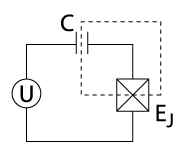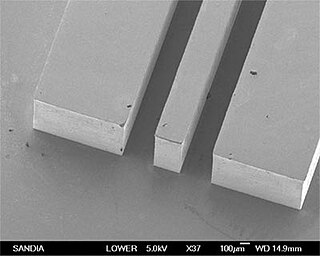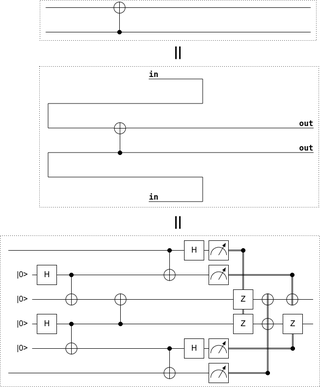Quantum error correction (QEC) is used in quantum computing to protect quantum information from errors due to decoherence and other quantum noise. Quantum error correction is theorised as essential to achieve fault tolerant quantum computing that can reduce the effects of noise on stored quantum information, faulty quantum gates, faulty quantum preparation, and faulty measurements. This would allow algorithms of greater circuit depth.

In quantum computing, a charge qubit is a qubit whose basis states are charge states. In superconducting quantum computing, a charge qubit is formed by a tiny superconducting island coupled by a Josephson junction to a superconducting reservoir. The state of the qubit is determined by the number of Cooper pairs that have tunneled across the junction. In contrast with the charge state of an atomic or molecular ion, the charge states of such an "island" involve a macroscopic number of conduction electrons of the island. The quantum superposition of charge states can be achieved by tuning the gate voltage U that controls the chemical potential of the island. The charge qubit is typically read-out by electrostatically coupling the island to an extremely sensitive electrometer such as the radio-frequency single-electron transistor.
Superconducting quantum computing is a branch of solid state quantum computing that implements superconducting electronic circuits using superconducting qubits as artificial atoms, or quantum dots. For superconducting qubits, the two logic states are the ground state and the excited state, denoted respectively. Research in superconducting quantum computing is conducted by companies such as Google, IBM, IMEC, BBN Technologies, Rigetti, and Intel. Many recently developed QPUs use superconducting architecture.
In physics, quantum acoustics is the study of sound under conditions such that quantum mechanical effects are relevant. For most applications, classical mechanics are sufficient to accurately describe the physics of sound. However very high frequency sounds, or sounds made at very low temperatures may be subject to quantum effects.

In quantum computing, more specifically in superconducting quantum computing, flux qubits are micrometer sized loops of superconducting metal that is interrupted by a number of Josephson junctions. These devices function as quantum bits. The flux qubit was first proposed by Terry P. Orlando et al. at MIT in 1999 and fabricated shortly thereafter. During fabrication, the Josephson junction parameters are engineered so that a persistent current will flow continuously when an external magnetic flux is applied. Only an integer number of flux quanta are allowed to penetrate the superconducting ring, resulting in clockwise or counter-clockwise mesoscopic supercurrents in the loop to compensate a non-integer external flux bias. When the applied flux through the loop area is close to a half integer number of flux quanta, the two lowest energy eigenstates of the loop will be a quantum superposition of the clockwise and counter-clockwise currents. The two lowest energy eigenstates differ only by the relative quantum phase between the composing current-direction states. Higher energy eigenstates correspond to much larger (macroscopic) persistent currents, that induce an additional flux quantum to the qubit loop, thus are well separated energetically from the lowest two eigenstates. This separation, known as the "qubit non linearity" criteria, allows operations with the two lowest eigenstates only, effectively creating a two level system. Usually, the two lowest eigenstates will serve as the computational basis for the logical qubit.
A quantum bus is a device which can be used to store or transfer information between independent qubits in a quantum computer, or combine two qubits into a superposition. It is the quantum analog of a classical bus.
In quantum computing, and more specifically in superconducting quantum computing, the phase qubit is a superconducting device based on the superconductor–insulator–superconductor (SIS) Josephson junction, designed to operate as a quantum bit, or qubit.
Steven M. Girvin is an American physicist who is the Eugene Higgins Professor of Physics at Yale University and who served as deputy provost for research at Yale from 2007 to 2017. Girvin is noted for his theoretical work on quantum many body systems such as the fractional quantum Hall effect, and as co-developer of circuit QED, the application of the ideas of quantum optics to superconducting microwave circuits. Circuit QED is now the leading architecture for construction of quantum computers based on superconducting qubits.

In quantum computing, and more specifically in superconducting quantum computing, a transmon is a type of superconducting charge qubit designed to have reduced sensitivity to charge noise. The transmon was developed by Robert J. Schoelkopf, Michel Devoret, Steven M. Girvin, and their colleagues at Yale University in 2007. Its name is an abbreviation of the term transmission line shunted plasma oscillation qubit; one which consists of a Cooper-pair box "where the two superconductors are also [capacitively] shunted in order to decrease the sensitivity to charge noise, while maintaining a sufficient anharmonicity for selective qubit control".
In quantum mechanics, the cat state, named after Schrödinger's cat, is a quantum state composed of two diametrically opposed conditions at the same time, such as the possibilities that a cat is alive and dead at the same time.

Coplanar waveguide is a type of electrical planar transmission line which can be fabricated using printed circuit board technology, and is used to convey microwave-frequency signals. On a smaller scale, coplanar waveguide transmission lines are also built into monolithic microwave integrated circuits.

Michel Devoret is a French physicist and F. W. Beinecke Professor of Applied Physics at Yale University. He also holds a position as the Director of the Applied Physics Nanofabrication Lab at Yale. He is known for his pioneering work on macroscopic quantum tunneling, and the single-electron pump as well as in groundbreaking contributions to initiating the fields of circuit quantum electrodynamics and quantronics.

Yasunobu Nakamura (中村 泰信 Nakamura Yasunobu) is a Japanese physicist. He is a professor at the University of Tokyo's Research Center for Advanced Science and Technology (RCAST) and the Principal Investigator of the Superconducting Quantum Electronics Research Group (SQERG) at the Center for Emergent Matter Science (CEMS) within RIKEN. He has contributed primarily to the area of quantum information science, particularly in superconducting quantum computing and hybrid quantum systems.

Irfan Siddiqi is an American physicist and currently a professor of physics at the University of California, Berkeley and a faculty scientist at Lawrence Berkeley National Laboratory (LBNL). He currently is the director of the Quantum Nanoelectronics Laboratory at UC Berkeley and the Advanced Quantum Testbed at LBNL. Siddiqi is known for groundbreaking contributions to the field of superconducting quantum circuits, including dispersive single-shot readout of superconducting quantum bits, quantum feedback, observation of single quantum trajectories, and near-quantum limited microwave frequency amplification. In addition to other honors, for his pioneering work in superconducting devices, he was awarded with the American Physical Society George E. Valley, Jr. Prize in 2006, "for the development of the Josephson bifurcation amplifier for ultra-sensitive measurements at the quantum limit." Siddiqi is a fellow of the American Physical Society and a recipient of the UC Berkeley Distinguished Teaching Award in 2016.

Andreas Wallraff is a German physicist who conducts research in quantum information processing and quantum optics. He has taught as a professor at ETH Zürich in Zürich, Switzerland since 2006. He worked as a research scientist with Robert J. Schoelkopf at Yale University from 2002 to 2005, during which time he performed experiments in which the coherent interaction of a single photon with a single quantum electronic circuit was observed for the first time. His current work at ETH Zürich focuses on hybrid quantum systems combining superconducting electronic circuits with semiconductor quantum dots and individual Rydberg atoms as well as quantum error correction with superconducting qubits.

Jerry M. Chow is a physicist who conducts research in quantum information processing. He has worked as the manager of the Experimental Quantum Computing group at the IBM Thomas J. Watson Research Center in Yorktown Heights, New York since 2014 and is the primary investigator of the IBM team for the IARPA Multi-Qubit Coherent Operations and Logical Qubits programs. After graduating magna cum laude with a B.A. in physics and M.S. in applied mathematics from Harvard University, he went on to earn his Ph.D. in 2010 under Robert J. Schoelkopf at Yale University. While at Yale, he participated in experiments in which superconducting qubits were coupled via a cavity bus for the first time and two-qubit algorithms were executed on a superconducting quantum processor.

Quantum gate teleportation is a quantum circuit construction where a gate is applied to target qubits by first applying the gate to an entangled state and then teleporting the target qubits through that entangled state.
Katherine E. Aidala is an American physicist. She is a professor of physics at Mount Holyoke College and a Fellow of the American Physical Society. She studies the fundamental properties of materials and devices, providing insight that could lead to technological innovation.

Jeremy Levy is an American physicist who is a Distinguished Professor of Physics at the University of Pittsburgh.
Andrew A. Houck is an American physicist, quantum information scientist, and professor of electrical and computer engineering at Princeton University. He is director of the Co-Design Center for Quantum Advantage, a national research center funded by the U.S. Department of Energy Office of Science, as well as co-director of the Princeton Quantum Initiative. His research focuses on superconducting electronic circuits to process and store information for quantum computing and to simulate and study many-body physics. He is a pioneer of superconducting qubits.











